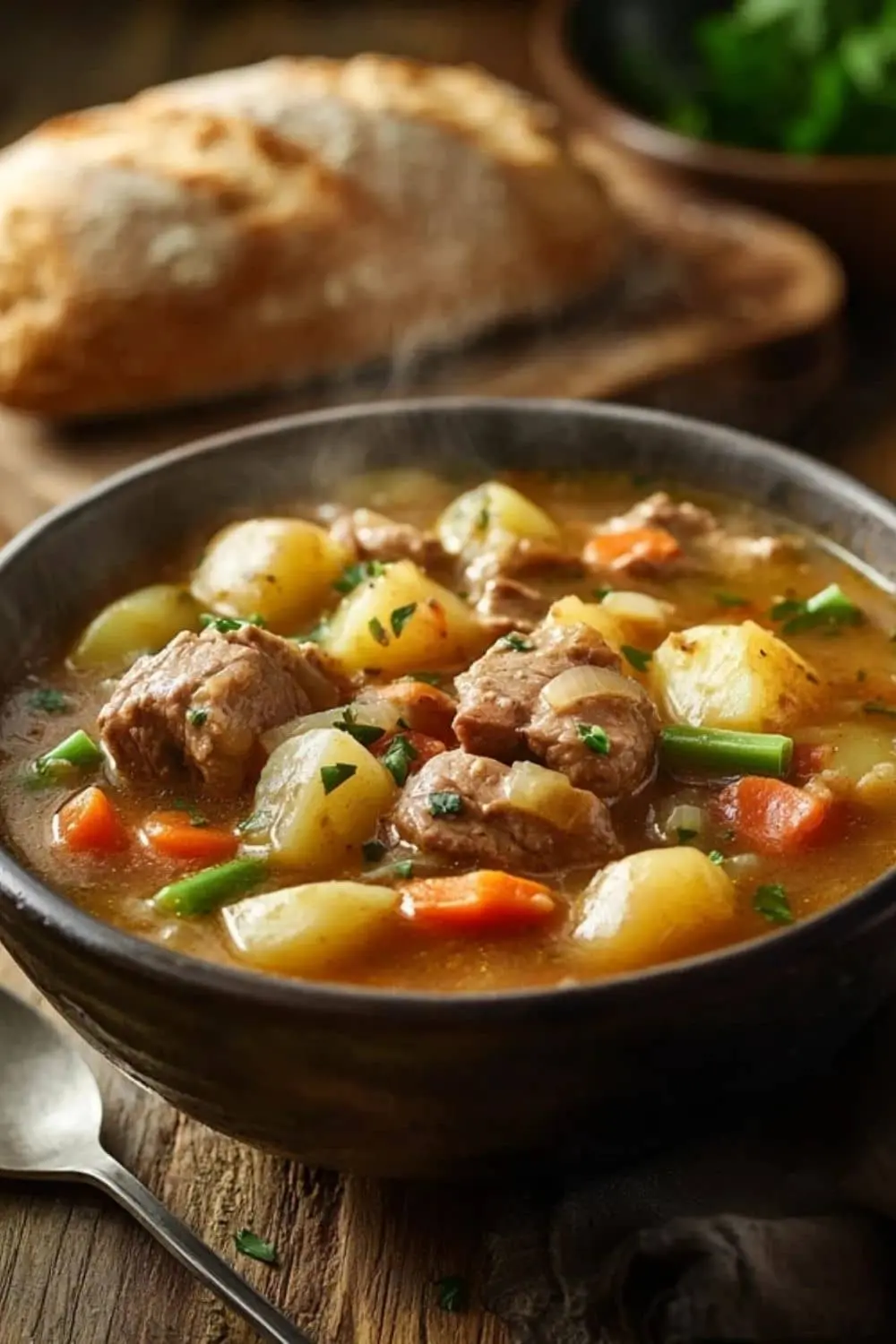Hearty Mulligan Stew is a rustic, hearty dish that has long been associated with resourcefulness and community cooking. Often made with whatever ingredients are available, this stew is a testament to making the best of limited resources while still enjoying a warm, nourishing meal.
Unlike traditional stews that follow a strict recipe, Hearty Mulligan Stew is adaptable. Its origins lie in the improvisational cooking style of hobos, soldiers, and communities that relied on shared resources to create a filling and satisfying dish. Today, it remains a favorite comfort food, often prepared in large batches to feed families or groups.
Table of Contents
The Origins of Hearty Mulligan Stew: From Hobo Camps to Home Kitchens
A Dish Born from Necessity and Resourcefulness
The history of Hearty Mulligan Stew dates back to the early 20th century, when it was commonly prepared by transient workers, hobos, and soldiers during difficult times. The name “Mulligan” is thought to have originated from Irish immigrants who brought their tradition of hearty stews to America. These early versions of Mulligan Stew were often cooked in makeshift camps using whatever ingredients were available, from meat scraps to potatoes and vegetables foraged or donated by kind-hearted locals.
During the Great Depression, this stew became even more widespread. Families struggling to put food on the table found that pooling their resources could create a meal large enough to sustain an entire group. This communal approach to cooking turned Mulligan Stew into more than just a dish it became a symbol of resilience and unity.
How Hearty Mulligan Stew Became a Symbol of Community and Sharing
What makes Mulligan Stew unique is not just its flavor but the tradition of shared cooking that surrounds it. In hobo camps, for instance, a common practice involved individuals contributing whatever they had be it a potato, a piece of meat, or a handful of beans into a communal pot. The result was a rich, flavorful stew that reflected the generosity of those who participated.
This communal cooking method carried over to soup kitchens, church gatherings, and even military camps, where large batches of Mulligan Stew provided nourishment to groups in need. Today, while it is no longer a necessity, the dish continues to be made at social gatherings, reinforcing its legacy as a meal that brings people together.
Essential Ingredients for the Perfect Hearty Mulligan Stew
Although the defining characteristic of Mulligan Stew is its flexibility, there are a few key ingredients that give it its signature taste and texture.
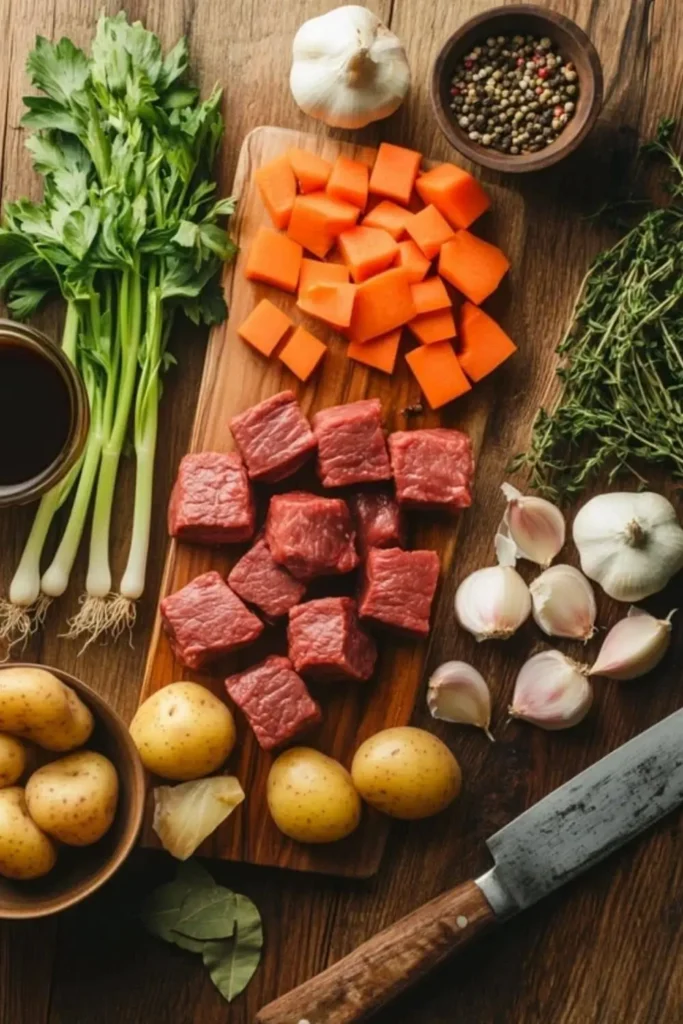
Choosing the Right Meat: Traditional vs. Modern Options
Traditionally, Mulligan Stew was made using whatever meat was available, including wild game, beef scraps, or canned meats. Today, home cooks have more options, and the most common choices include:
- Beef chuck or stew meat – Tender and rich in flavor when slow-cooked.
- Pork shoulder – Adds a slightly sweeter taste to the stew.
- Chicken thighs – A lighter alternative that still offers deep flavor.
- Sausage or smoked meats – Used in Southern variations for extra depth.
For a more modern twist, some cooks even use plant-based proteins like lentils or seitan to create a vegetarian version of this classic dish.
Vegetables That Enhance Flavor and Nutrition
A well-balanced Mulligan Stew includes a mix of root vegetables and greens, making it both hearty and nutritious. Some of the most common vegetables used are:
- Potatoes – Essential for adding texture and heartiness.
- Carrots – Provide natural sweetness.
- Onions and Garlic – Essential for depth of flavor.
- Celery – Adds a slight crunch and mild bitterness.
- Peas or Green Beans – Common additions in more modern versions.
- Cabbage – A traditional ingredient that enhances the stew’s richness.
Because this stew is so adaptable, some people add seasonal vegetables like corn, bell peppers, or mushrooms to change up the flavors.
Herbs and Spices: The Secret to a Flavorful Stew
The seasoning of Mulligan Stew varies based on regional influences and personal preference, but some classic herbs and spices help bring out the best flavors:
- Salt and black pepper – The foundation of any well-seasoned stew.
- Bay leaves – Add a subtle depth of flavor.
- Thyme and rosemary – Provide an earthy aroma.
- Paprika – Adds a slight smokiness and color.
- Worcestershire sauce – A secret ingredient for umami richness.
For a spicier version, some cooks also include red pepper flakes, cayenne, or hot sauce to give the stew a little kick.
How to Make Hearty Mulligan Stew: Step-by-Step Guide
Now that we’ve explored the history and essential ingredients of Mulligan Stew, it’s time to get into the cooking process. This step-by-step guide will help you create a delicious, hearty stew that stays true to its rustic origins while allowing for personal customization.
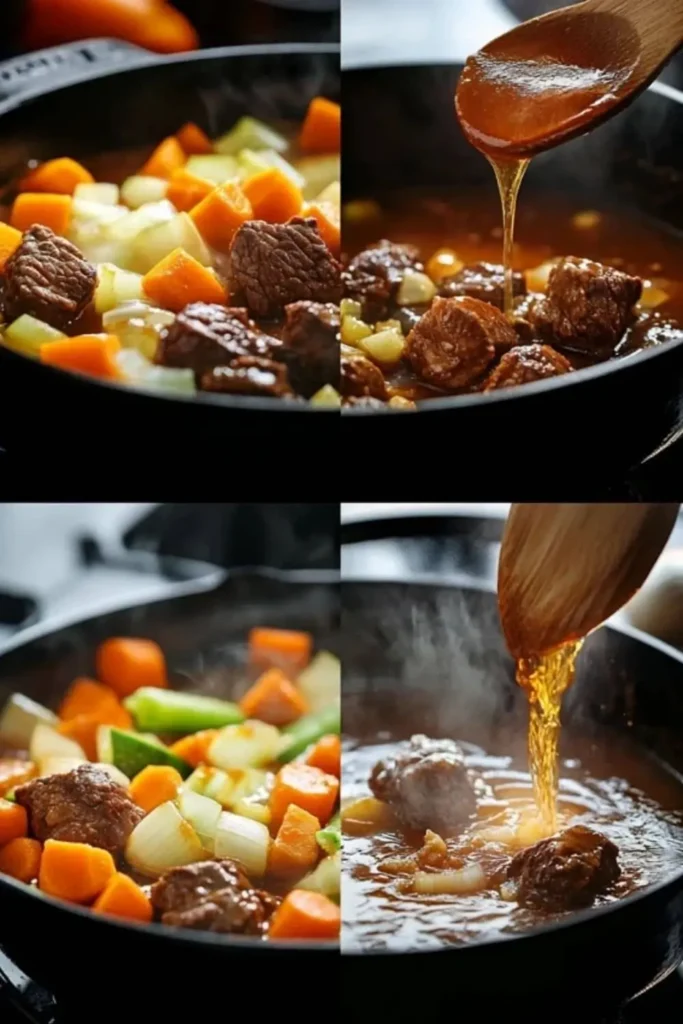
Preparing the Ingredients: Cutting, Marinating, and Seasoning
Before cooking, it’s important to properly prepare each ingredient to ensure even cooking and maximum flavor.
- Cut the meat into bite-sized chunks – If using beef, pork, or chicken, trim excess fat but leave some for richness.
- Season the meat – Coat it with salt, black pepper, and paprika for depth.
- Chop the vegetables – Dice onions, carrots, and potatoes into uniform pieces to ensure they cook evenly.
- Pre-mix herbs and spices – Combine bay leaves, thyme, and Worcestershire sauce in a small bowl for easy access during cooking.
Pro Tip: For extra tenderness, marinate the meat in Worcestershire sauce and a bit of vinegar for 30 minutes before cooking.
Cooking Techniques: Slow Cooker vs. Instant Pot vs. Stovetop
Mulligan Stew is incredibly versatile, and the cooking method you choose will impact both the texture and flavor of the final dish.
Stovetop Method (Traditional)
- Best for hands-on cooking with maximum flavor development.
- Steps:
- Heat oil in a large pot or Dutch oven over medium-high heat.
- Sear the seasoned meat until browned on all sides.
- Add onions and garlic, sauté until fragrant.
- Stir in the vegetables, followed by broth and seasonings.
- Simmer on low heat for 1.5 to 2 hours, stirring occasionally.
Slow Cooker Method (Set and Forget)
- Best for busy cooks who want a hands-off approach.
- Steps:
- Sear the meat in a separate pan for added flavor.
- Transfer meat, vegetables, and broth into a slow cooker.
- Set to low for 6-8 hours or high for 4-5 hours.
- Stir before serving and adjust seasoning.
Instant Pot Method (Fast and Convenient)
- Best for quick cooking without compromising flavor.
- Steps:
- Use the “Sauté” function to brown the meat.
- Add vegetables, broth, and seasonings.
- Seal the lid and cook on high pressure for 35 minutes.
- Allow for natural pressure release before serving.
Pro Tips for Enhancing the Flavor and Texture
- Deglaze the pan: After searing meat, pour in a splash of wine or broth to lift the browned bits from the bottom. This intensifies the stew’s flavor.
- Don’t rush the simmering: Slow cooking allows flavors to meld and develop richness.
- Adjust thickness: For a thicker stew, mash a few potatoes or add a cornstarch slurry.
- Let it rest before serving: Allowing the stew to sit for 10-15 minutes enhances the taste.
Variations of Mulligan Stew Across Different Cultures
Mulligan Stew is adaptable, and different regions have their own take on this classic dish. Here are some notable variations:
Irish Influence: The Connection to Irish Stew
Many believe that Mulligan Stew was inspired by traditional Irish stew, which shares similarities in ingredients and preparation. The key differences are:
| Feature | Mulligan Stew | Irish Stew |
|---|---|---|
| Meat Used | Beef, pork, or mixed meats | Lamb or mutton |
| Broth Base | Beef or vegetable broth | Light broth, sometimes beer |
| Seasonings | Worcestershire, paprika, garlic | Simple herbs like thyme and bay leaves |
Southern Style Mulligan Stew: A Spicier Take
In the Southern U.S., Mulligan Stew is often made with smoked sausage, okra, and tomatoes, giving it a spicier and richer taste. Cajun-style versions may include hot sauce or cayenne pepper for an extra kick.
Vegetarian and Vegan Adaptations for a Modern Twist
For a plant-based version, swap out meat for hearty alternatives like:
- Lentils or chickpeas – Protein-rich and filling.
- Mushrooms – Add a meaty texture.
- Jackfruit – Mimics shredded meat when slow-cooked.
Instead of beef broth, use a vegetable broth infused with umami-rich soy sauce or miso for depth.
Common Mistakes to Avoid When Making Mulligan Stew
Even though Mulligan Stew is known for its flexibility, certain mistakes can affect the final flavor and texture. Here are some of the most common errors and how to avoid them.
Overcooking or Undercooking the Ingredients
- Mistake: Cooking meat for too long on high heat can make it tough, while undercooking root vegetables like potatoes and carrots results in a crunchy, unpleasant texture.
- Solution: Always simmer on low heat for at least 1.5 to 2 hours on the stovetop or slow cook for 6-8 hours for the best results. If using an Instant Pot, follow recommended pressure cooking times to avoid overcooking.
Using Too Much or Too Little Seasoning
- Mistake: Adding too much salt or spices at the beginning can make the stew overpowering. On the other hand, a lack of seasoning can leave it bland.
- Solution: Season gradually and adjust flavors towards the end. Let the stew simmer for a while before adding additional spices.
Choosing the Wrong Type of Meat for the Dish
- Mistake: Using lean meats like chicken breast or pork loin can result in a dry, less flavorful stew.
- Solution: Stick to fattier cuts like beef chuck, pork shoulder, or chicken thighs for better tenderness and richness.
The Best Side Dishes to Serve with Mulligan Stew
Pairing Mulligan Stew with the right side dishes enhances the meal. Here are some classic and creative options.
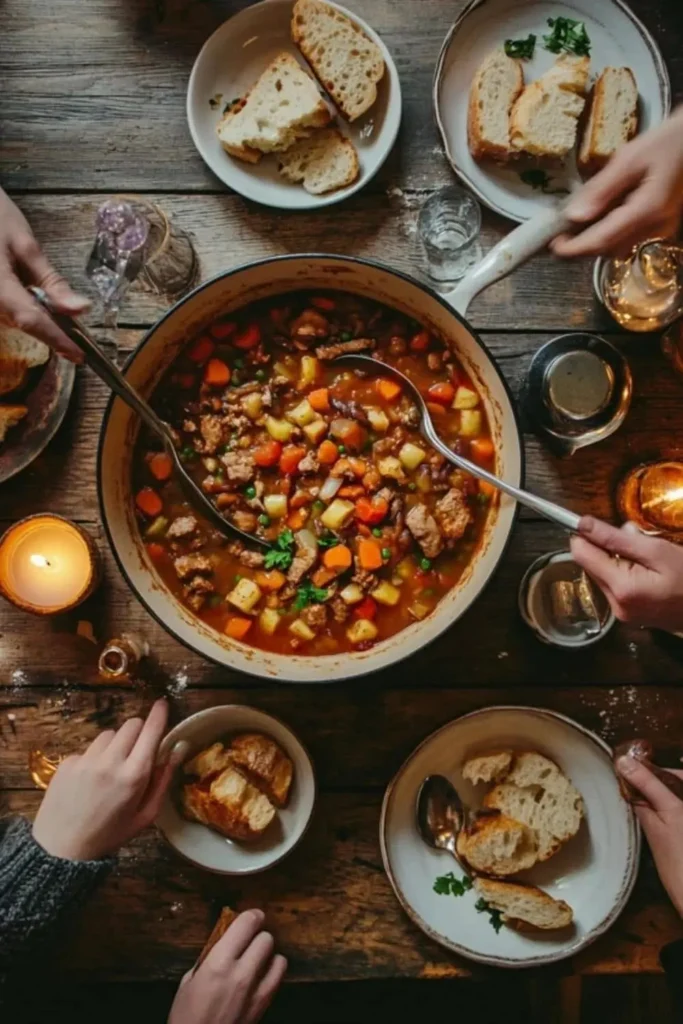
Classic Pairings: Bread, Cornbread, and Rice
- Crusty Bread – Perfect for dipping into the rich broth.
- Cornbread – A Southern favorite that adds a slight sweetness.
- Steamed Rice – Helps soak up the flavors of the stew.
Fresh Salads and Pickles for a Refreshing Contrast
- Crisp Green Salad – A light side dish to balance the hearty stew.
- Pickled Vegetables – Adds a tangy contrast to the rich flavors.
Beverage Pairings: What to Drink with Mulligan Stew
- Red Wine – A full-bodied red like Cabernet Sauvignon pairs well.
- Dark Beer – Complements the deep, savory flavors.
- Herbal Tea – A caffeine-free option that aids digestion.
Frequently Asked Questions (FAQs)
Can I Make Mulligan Stew in a Slow Cooker or Instant Pot?
Yes! Slow cookers and Instant Pots are great for this dish. Use low heat for 6-8 hours in a slow cooker or pressure cook for 35 minutes in an Instant Pot.
How Long Does Mulligan Stew Last in the Fridge?
Mulligan Stew stays fresh for 3-4 days when stored in an airtight container in the refrigerator.
Can I Freeze Mulligan Stew for Later?
Absolutely! Let the stew cool completely, then freeze it in airtight containers for up to 3 months. Thaw overnight in the fridge and reheat on the stovetop.
What Meat Works Best for Mulligan Stew?
The best meats are beef chuck, pork shoulder, or chicken thighs, as they remain tender and flavorful during slow cooking.
How Can I Make Mulligan Stew Healthier?
For a healthier version:
- Use leaner meats or plant-based proteins.
- Reduce sodium by limiting added salt and using low-sodium broth.
- Add more vegetables for extra nutrients.
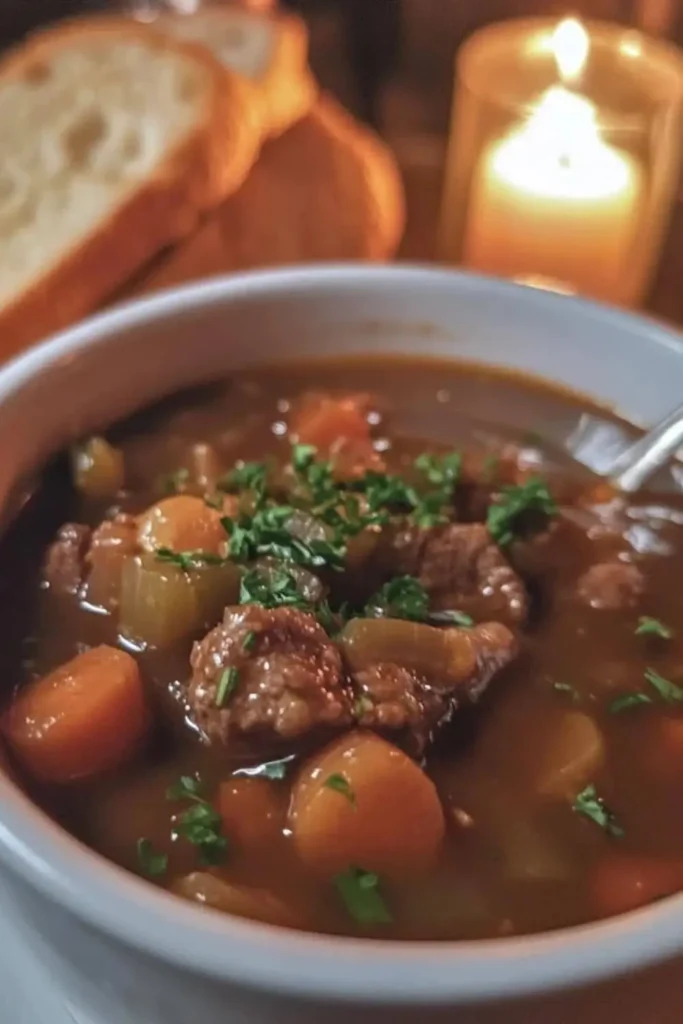
Conclusion: Why Mulligan Stew Remains a Beloved Dish
Mulligan Stew is more than just a recipe it’s a symbol of resilience, resourcefulness, and community. Whether you follow a traditional approach or put your own spin on it, this stew is a comforting, hearty meal that brings people together.
Next time you’re looking for an easy, adaptable, and delicious dish, give Mulligan Stew a try. No matter how you make it, it will always provide a warm, satisfying meal for you and your loved ones.
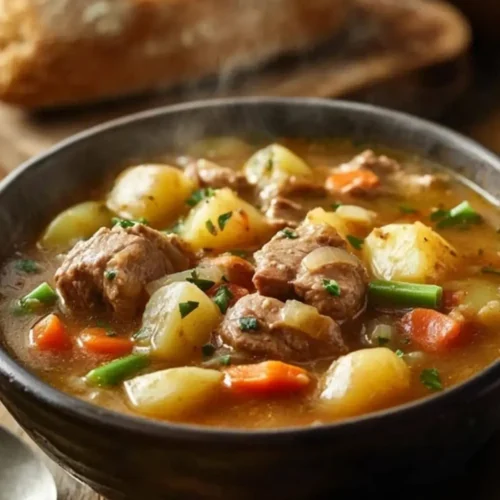
Hearty Mulligan Stew
Equipment
- Large Dutch Oven or Stock Pot
- Wooden spoon
- Knife
- Cutting Board
- Slow Cooker (Optional)
- Instant Pot (Optional)
Ingredients
Meat
- 1 1/2 lbs beef chuck or stew meat cut into bite-sized chunks
- 1 tbsp vegetable oil for searing the meat
Vegetables
- 1 large onion chopped
- 3 cloves garlic minced
- 3 medium carrots peeled and chopped
- 3 medium potatoes peeled and diced
- 2 stalks celery chopped
- 1 cup green beans trimmed and chopped
Broth and Seasonings
- 4 cups beef broth
- 1 can diced tomatoes (14.5 oz), with juices
- 1 tbsp Worcestershire sauce adds depth of flavor
- 1 tsp salt or to taste
- 1/2 tsp black pepper
- 1 tsp paprika optional, adds mild smokiness
- 1 tsp dried thyme
- 1 tsp dried rosemary
- 1 bay leaf remove before serving
Instructions
- Heat oil in a large Dutch oven over medium-high heat. Sear the beef chunks on all sides until browned. Remove and set aside.
- In the same pot, sauté onions and garlic until softened and fragrant, about 3 minutes.
- Add the carrots, potatoes, celery, and green beans. Stir and cook for 3-4 minutes.
- Return the beef to the pot and pour in the beef broth and diced tomatoes with juices.
- Add Worcestershire sauce, salt, pepper, paprika, thyme, rosemary, and bay leaf. Stir well.
- Bring to a boil, then reduce heat to low. Cover and let simmer for 1.5 to 2 hours, stirring occasionally.
- Remove the bay leaf and adjust seasoning if needed.
- Serve hot with crusty bread or cornbread.

